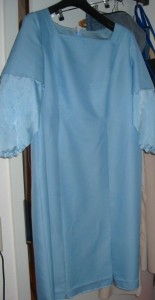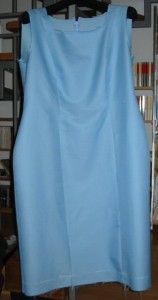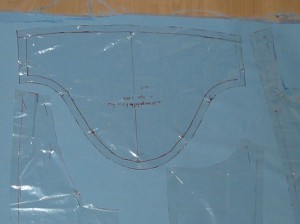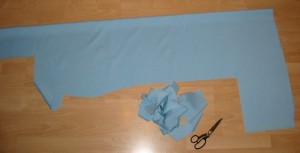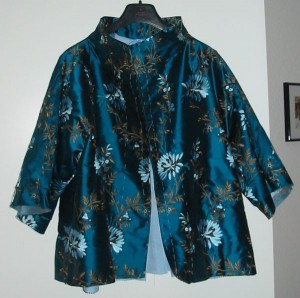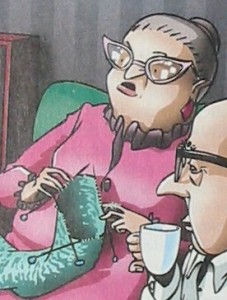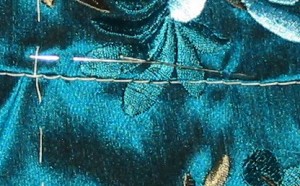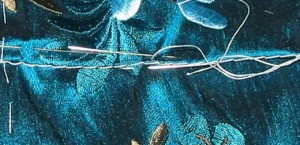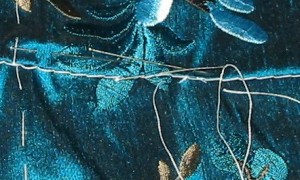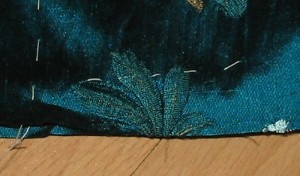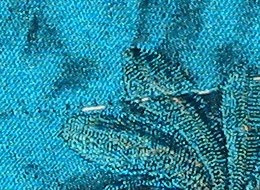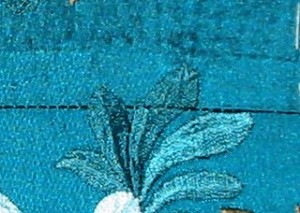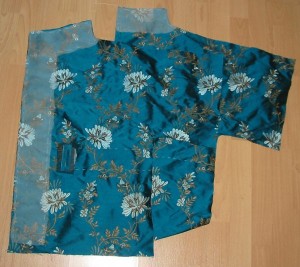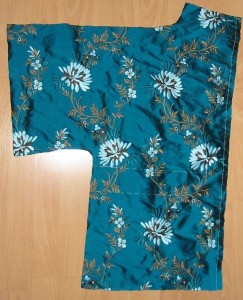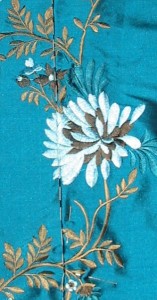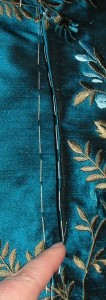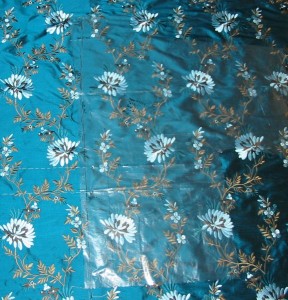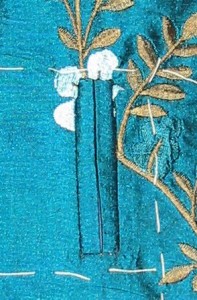Findings on the h&h trade fair 2010
Die Vernunft hätte ja am Freitag geboten, mein Kleid fertig zu nähen. Aber da ich die Karte für die h&h hatte, konnte ich der Versuchung doch nicht widerstehen. (Und wollte auch nicht, ich gestehe.) Aber ich habe Vormittags noch gestichelt, sechs Stunden bis 18.00 Uhr reichten auch für platte Füße. Kaufen konnte ich ja glücklicherweise nichts, es ist eine Händlermesse. Trotzdem habe ich eine Menge mitbegracht, Eindrücke vor allem. Und noch ein paar Kleinigkeiten als Gedächtnisstütze für selbige. 🙂
Reason had told me to finish my dress on friday, but since I had a ticket for the h&h (trade show for professionals) so I couldn’t (and wouldn’t) resist the temptation. But I had done some sewing in the morning and six hours were still a lot of time to get aching feet. The trade show is for professionals only, so if you are not a show owner and want to order bigger amounts of everything, you cannot buy. So I couldn’t buy anything, but I got a lot of impressions. And also some things to help me remember those impressions. 🙂
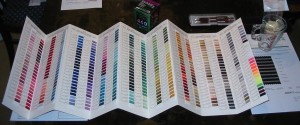 Daß ich bei Alterfil vorbeischauen würde um mich noch mal für die Challengepreise und mein Weihnachtsgeschenk zu bedanken war natürlich Ehrensache. Und dann klebte ich schon wieder an den schönen Farben… für den Handel gibt es jetzt übrigens ein schickes und modulares Plexiglas-Display… aber diesmal nicht am Nähgarn, sondern am Stickgarn!
Daß ich bei Alterfil vorbeischauen würde um mich noch mal für die Challengepreise und mein Weihnachtsgeschenk zu bedanken war natürlich Ehrensache. Und dann klebte ich schon wieder an den schönen Farben… für den Handel gibt es jetzt übrigens ein schickes und modulares Plexiglas-Display… aber diesmal nicht am Nähgarn, sondern am Stickgarn!
Das Super-Bright Polyester ist jetzt nämlich in 453 Farben erhältlich! Die Garne sind übrigens auch schon im Webshop erhältlich. (Und haben eine Pantone-Nummer, sind also sozusagen standardisiert, was gerade wenn man viel bestellt praktisch ist.)
Das nachtleuchtende Moonglow war mir hingegen nicht neu, das habe ich schon hier, nur noch nicht ausprobiert…
That I would visit the Alterfil booth to say thank you for the Challenge prizes and for my christmas gift was clear. And then I was again thrilled not only by the new chic looking and modular acrylic glass displays for shop owners, but also by the choice of colors. This time not only of the sewing thread but of the Super Bright embroidery thread! What started with some colours last year has arrived at a choice of 453 colors! (All available at the web shop also.) And I got a color chart. 🙂 Moonglow is not completely new in the show, because I already purchased some with my last order….
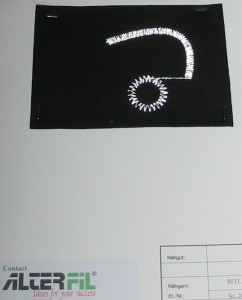 Ein starkes “haben will” erzeugte auch das Reflexgarn. Mit Blitz sieht man wirklich gut, wie stark es reflektiert. Ganz feine Glassplitter sorgen dafür, wenn ich das richtig verstanden habe.
Ein starkes “haben will” erzeugte auch das Reflexgarn. Mit Blitz sieht man wirklich gut, wie stark es reflektiert. Ganz feine Glassplitter sorgen dafür, wenn ich das richtig verstanden habe.
Was mir besonders gut gefällt ist auch, daß es ohne Licht relativ wenig glitzert, sondern eher neutral grau aussieht. So kann man es auch an Kleidung, Taschen oder Accessoires für Erwachsene verwenden, ohne daß man sich wie eine Barbie fühlt.
Weniger schön ist, daß es technisch noch nicht möglich ist, diesen Faden auf kleine Rollen zu spulen, so daß er im Moment nur auf großen Konen zu haben ist und mit 70 EUR dann doch eine ziemliche Investition darstellt. *schluck*
Another “wanna have” is this reflective thread. Flashlight shows how well it reflects the light! (Due to extremely fine glass particles if I got that right.)
What I like a lot is that the thread is not very “glitzy” in its “normal” state, but more a neutral grey. So it’s not only great for more security on kids gear, but also good for clothes or bags for adults that do not want to feel like Barbie.
Not so good is the fact that they have not found a technical solution to bring it on smaller spools so you can only have big cones which cost around 70 EUR each which is quite an investment. *ouch*
Der kleine Karton mit neun 200m Röllchen war auf der Messe ein Give-Away, aber es ist angedacht, solche kleinen Sortimenter auch im Webshop anzubieten, etwa passend zu aktuellen Modetrends. Auch neu und demnächst im Shop sind Schrägbänder. In Zusammenarbeit mit Topp, einem Hersteller für Bänder aller Art, der sonst im großen Rahmen für die Industrie herstellt (eine Rolle sind 140m) werden zwei Qualitäten in verschiedenen Breiten und Farben angeboten werden. Passend zum Faden (oder umgekehrt) und in handhabbareren Rollen von 20m.
The small box with 9 spools of 200m was just the give away but there are plans to offer boxes like that in the shop, for example variations according to fashion trends. Another new idea that will arrive in the shop soon are bias tapes. In cooperations with Topp, a producer that normally cuts for industry (so one spool means 140m) they will offer bias tapes in two qualities and in many colors. Fitting the threads (or vice versa) and in more convenient spools of 20m.
Na und nachdem ich dann auch schon die Pralinen, die Kugelschreiber und die Tasse von Gritzner in die Hand bekommen habe, habe ich auch mal einen Blick auf die Maschinen geworfen und mir das mal alles erklären lassen. Den Gritzner war doch mal die von Pfaff als Billiglable verwendete schon lange nicht mehr existente Marke?
Aber zum Anfang… Pfaff wurde ja auch vor einigen Jahren aufgekauft und stellt auch seit einigen Jahren in Deutschland keine Haushaltsmaschinen mehr her. Die Produktionsstraßen der alten Maschinen wurden in den Iran verkauft und produzieren dort weiter. Und diese Maschinen werden schon seit einiger Zeit auch nach Deutschland importiert. Jetzt hat der Importeur zu den Maschinen (praktischerweise der Sohn von Herrn Seitz von Alterfil…) inzwischen auch die Rechte an den Marken “Gritzner” und “Kayser” für Deutschland erworben. Also laufen die “neuen alten” Pfaffmodelle künftig unter dem Namen Gritzner in Deutschland. Wer also die gewohnte Technik der 80er nicht aufgeben will, kann sie auch frisch gefertigt im Fachhandel erwerben. Und… drei der Modelle werden seit ganz kurzer Zeit auch wieder in Deutschland zusammengesetzt. Mal sehen, ob da wieder Kultmaschinen draus werden.
Alterfil was not alone in the booth, they shared with Gritzner (where the son of Mr Seitz form Alterfil is the owner). So Gritzner was a german brand before they were bought by Pfaff very long ago and used as a cheap label. And… now? But information is why those shows are so valuable. Pfaff has new owners for years already and they stopped production of home sewing machines in Germany some years ago. The machinery was sold to Iran and went on making sewing machines. Those were imported back to Germany. Now the importer also got the rights to use the brand names “Gritzner” and “Kayser”. So in Germany the “new old” Pfaff models are sold now under the traditional name “Gritzner” in Germany. So for those who need a new machine but do not want to give up their 1980th technique those machines might be an alternative. Let’s see whether they will also become cult…
Die neue 3er Serie bei Bernina habe ich mir natürlich auch mal angeguckt. Das silbrige Design der 330er und 350er spricht mich ja nicht so an, denn der “gebürstetes Edelstahl”-Look ist inzwischen so oft aus Plastik nachgemacht, daß er nicht mehr wirklich wertig wirkt. Das Display mit heller Schrift auf schwarz ist auch nicht ganz mein Geschmack, aber an der Bernina 380 wird das Design dann rund. Und auch die Funktionen gefallen mir. Neben dem Kniehebel und einer großen Stichauswahl gibt es sogar einen Geschwindigkeitsregler und die Möglichkeit, ohne Fußpedal zu nähen. Nur bei einem angestrebten Preis von knapp 1400 EUR dürfte meiner Meinung nach auch ein verstellbarer Nähfußdruck noch drin sein. Das ist eine verschenkte Möglichkeit. (Aber vermutlich “dürfen” die Nachfolger der activa-Serie diese Funktion nicht haben…?)
Of course I checked also the new machines from Bernina. The design of the 330 and 350 I did not like to much and why the display is white on black… who knows? But on the Bernina 380 the elements fit together. And the machine has nearly all you need, from knee lever to a good choice of stitches, the possibility to sew without a pedal and a speed control on the machine. Only I miss the adjustable pressure foot, for nearly 1400 EUR retail price that should have been possible. (But since the 3 series will replace the activas this function is not “allowed”…?)
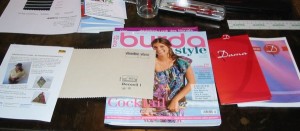 Überraschenderweise hat sich Frau Mitsch von Vlieseline auch an mich erinnert. Und mir das neue Decovil I gezeigt. Es ist aufbügelbar und mit der wildlederartigen Oberfläche kann man es direkt als Sohle für Puschen verwenden. Oder als Einlage, wobei ich natürlich gleich an Taschen denke. Es ist nämlich nicht so steif und knickanfällig wie Schabrackeneinlage aber deutlich fester als Volumenvlies. Sollte die perfekte Taschenverstärkung ergeben, aber auch für Gürtel o.ä. prima.
Überraschenderweise hat sich Frau Mitsch von Vlieseline auch an mich erinnert. Und mir das neue Decovil I gezeigt. Es ist aufbügelbar und mit der wildlederartigen Oberfläche kann man es direkt als Sohle für Puschen verwenden. Oder als Einlage, wobei ich natürlich gleich an Taschen denke. Es ist nämlich nicht so steif und knickanfällig wie Schabrackeneinlage aber deutlich fester als Volumenvlies. Sollte die perfekte Taschenverstärkung ergeben, aber auch für Gürtel o.ä. prima.
At the Vlieseline booth I detected the new Decovil I. It is a fusible non woven with a suede like surface and you can use it directely as sole for sewn slippers. Or as interlining for bags, because it is stable and does not get permanent creases as easily as other stiff and stable interfacings. Of course also suitable to make belts or hats.
Da mir die Entwicklung der Burdastyle über das letzte Jahr im Großen und Ganzen gut gefallen hat bin ich zum Loben zu Burda gegangen. Und wurde mit einem aktuellen Heft belohnt, was mir sehr zu pass kam, denn ich war tatsächlich noch nicht bis zum Kiosk gekommen. (Ein paar Anregungen konnte ich mir dann auch nicht verkneifen, etwa bei Braut- oder Abendkleidern nicht eine einfache, sondern eine adäquate Verarbeitung zu erklären. Und generell auch mal “schwierigere” Techniken zu erklären. Muß ja nicht jeden Monat sein, aber so ein oder zwei mal im Jahr an einem besonderen Modell… Wobei ich so zwischen den Zeilen verstanden habe, daß solche Techniken wohl in viel Mehrarbeit für die Redaktion resultieren. Weniger beim Erstellen der Anleitung, sondern hinterher, wenn Leserinnen anrufen, die es nicht verstanden haben und dann telefonisch Support brauchen. Aber als Buch könnten sie sich sowas vielleicht eher vorstellen. Auch das fände ich gut, denn Couture- und Schneidertechniken findet man momentan vor allem in Englischen Büchern und die kann hier halt nicht jeder lesen.)
Since I liked the over all developement of the Burdastyle magazine I went to their booth to tell them. And got the april issue which is perfect, because I hadn’t had time to buy one until then.
Über den Stand von Dama aus Spanien bin ich gestolpert, weil sie Klöppel hatten. (Wollte ich ja schon immer mal lernen, ein Buch habe ich auch dazu…) Um dann festzustellen daß sie eine metallverarbeitende Fabrik sind, die neben Fingerhüten vor allem Nadeln aller Art herstellt. (Und lustigerweise ihren Ursprung in Aachen haben.) Wirklich schön waren übrigens auch die Klöppel aus Glas und die nette Dame sagte, man könnte die wirklich verwenden…?
Dama from Spain attracted me because they had bobbins for lacemaking. Then I found out that they are a metallurgic fabric and produce all kinds of needles and pins. (And funily the company has the origins in Germany…) Very beautiful the crystal bobbins they had. They nice lady said they can actually be used…?
Liest noch jemand? Oder aufgegeben? Ich glaube, über die “Wollfindungen” erzähle ich ein andermal… 😉
Anyone still there? Everyone gave up? I think about my “wooly findings” I’ll write another day… 😉

